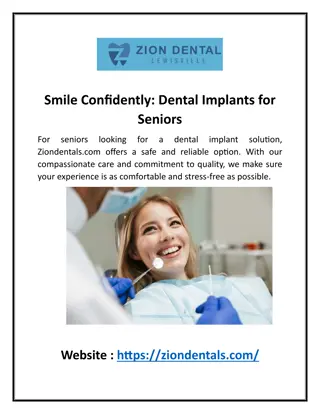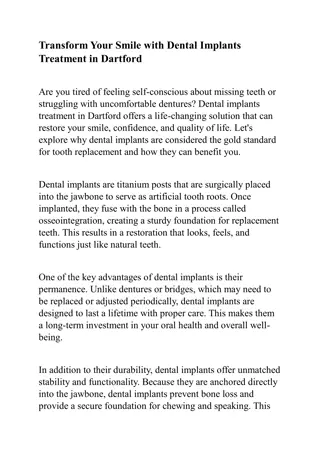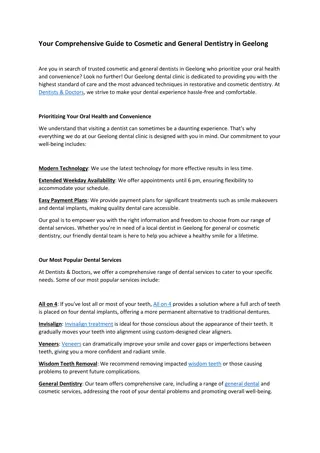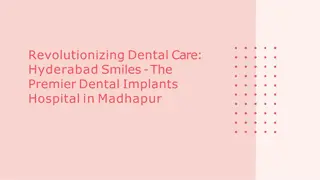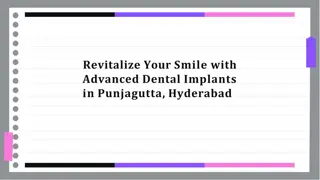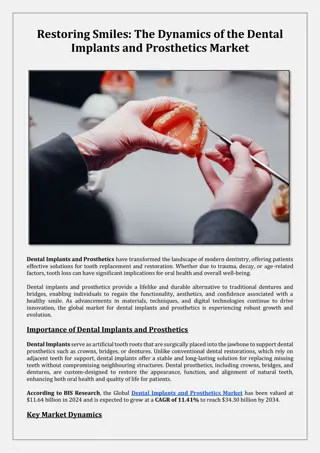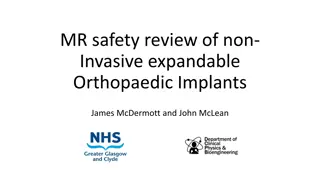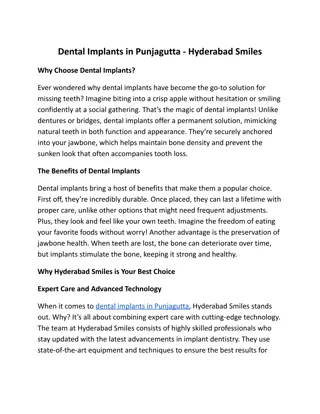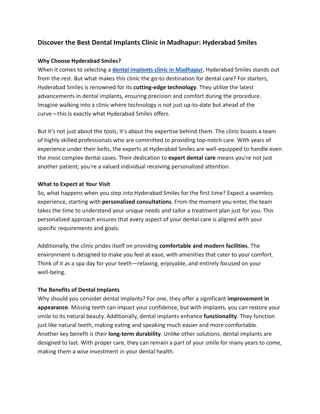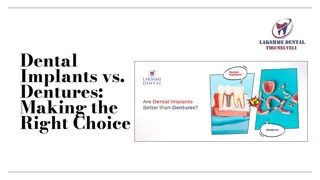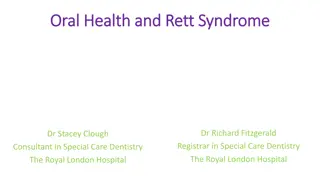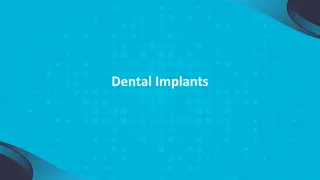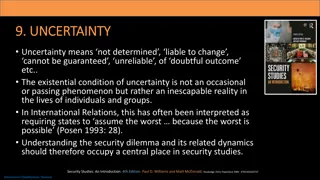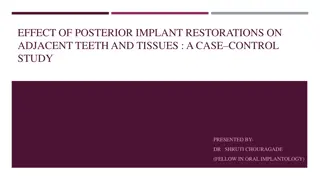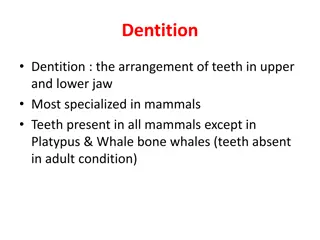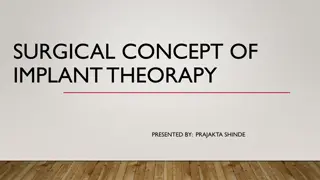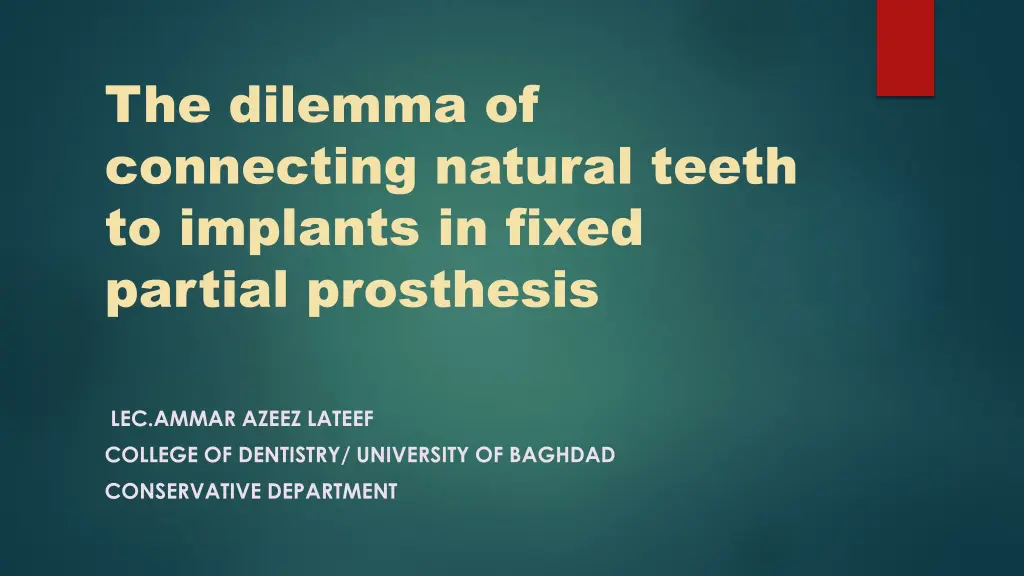
Connecting Natural Teeth to Implants in Fixed Prosthesis
Understanding the dilemma of connecting natural teeth to implants in fixed partial prosthesis involves considerations of implant design, osseointegration, primary stability, and bone healing processes. Different approaches such as non-rigid and rigid connections offer varying advantages and potential challenges, influencing the success of tooth-implant supported restorations.
Download Presentation

Please find below an Image/Link to download the presentation.
The content on the website is provided AS IS for your information and personal use only. It may not be sold, licensed, or shared on other websites without obtaining consent from the author. If you encounter any issues during the download, it is possible that the publisher has removed the file from their server.
You are allowed to download the files provided on this website for personal or commercial use, subject to the condition that they are used lawfully. All files are the property of their respective owners.
The content on the website is provided AS IS for your information and personal use only. It may not be sold, licensed, or shared on other websites without obtaining consent from the author.
E N D
Presentation Transcript
The dilemma of connecting natural teeth to implants in fixed partial prosthesis LEC.AMMAR AZEEZ LATEEF COLLEGE OF DENTISTRY/ UNIVERSITY OF BAGHDAD CONSERVATIVE DEPARTMENT
A dental implant is essentially a titanium/zirconia screw or cylinder, which is inserted into a prepared bony socket in the jaw and acts as a replacement root for the missing teeth to restore function and esthetics1. Osseointegration is the joining of implant to bone by remodeling and new bone apposition at implant-bone interface resulting in secondary stability of the implant2. Surface topography, design and wettability of the implants besides the non- invasive drilling and insertion torque play an important role in primary stability3
Traditional implants are the more secure and permanent option, but in case we have an atrophic bone, compromised patient s health that hinder doing multiple surgical procedure for bone augmentation so compressive or basal implants provide the reliable substitute. One pilot drill is usually needed for trans mucosal placement, so healing of gingiva occurs within 2-5 days. Upon insertion the distinctive design of threads increases bone-implant contact, tapered implant ( self-tapping system) produce more compressive forces than cylindrical at tooth- implant interface but the viscoelastic property of the bone increases resistance to that force for a short period of time making it possible to introduce higher insertion torque for adequate primary stability4-5.
Ideally designed implants would have a micro-movement of 50-150 m during the bone healing process, Bone regeneration requires a resting period with no mechanical loading in which one masticatory cycle takes about 0.8-1 sec6. Natural teeth have a vertical movement of 8-28 m and a horizontal movement of 56-73 m for posterior teeth and 97-108 m for anterior teeth even with small force like 500 gram while implants have vertical movement of 0-5 m related to the elastic property of bone. so that, connecting implants to posterior teeth may increase the success in implant tooth supported restorations7.
There are three schools regarding connecting teeth to implants, one adopts non-rigid connection, another prefers rigid connection and the third recommends no connection. Non-rigid connection: by utilizing key on tooth side and keyway attachment on the prosthesis, the mechanical binding between matrix and patrix precision and semiprecision attachment that could create microjamming preventing the tooth to return to its natural position causing disuse atrophy of the PDL. Another theory that the force applied on the prosthesis transmitted to the tooth connected to an implant may cause a wavey stress activating osteoclasts at the periapical area resulting in tooth intrusion13 15, to reduce this effect a telescopic crown with a vertical locking screw in the cemented coping has constructed.16 Rigid connection: By cementing the prosthesis directly on teeth and implants, with which implants could receive higher stress than the tooth especially with high number of pontics resulting in marginal bone loss17,18. Better results in tooth-implant FPDs success found in presence of interpositioning abutment19,20
Conclusion: Free standing implants would be the first choice for supporting fixed prosthesis whenever possible. Combining tooth to implant in FPDs could be the choice if we have a firm and stable posterior strategic tooth, by which bone volume and proprioception are maintained. To increase the success rate of tooth-implant FPDs, it is better to avoid using short implants, poor bone quality. Cantilever extensions must be avoided.
Long bridges and long saddle should be avoided as much as possible in tooth-implant FPDs. Rigid connection is preferred in tooth-implant FPDs, with increasing number of implants or teeth support in which parallelism should be taken in consideration to decrease the effect of horizontal stresses. Occlusal forces should be distributed evenly in tooth-implant FPDs. Tooth-implant connection should be avoided in patients with parafunctional habits. If we have to, then maximum implants must be used.
Referrences 1. https://www.efp.org/for-patients/dental-implants/dental-implants-explained/ Dental implants explained - European Federation of Periodontology. Accessed February 19, 2025. 2. osseointegration process?: An in vivo experimental biomechanical and histological evaluations. PLOS ONE. 2020;15. doi:10.1371/journal.pone.0233304 Gehrke S, Arambur Junior J, Perez-Diaz L, et al. Can changes in implant macrogeometry accelerate the 3. literature review. J Investig Clin Dent. 2016;7(3):217-224. doi:10.1111/jicd.12152 Al-SawaiAA, Labib H. Success of immediate loading implants compared to conventionally-loaded implants: a 4. and circular economy. Resources Policy. 2020;68:101767. doi:10.1016/j.resourpol.2020.101767 Yadav D, Garg R, AhlawatA, Chhabra D. 3D printable biomaterials for orthopedic implants: Solution for sustainable 5. 2014;41(10):783-794. doi:10.1111/joor.12195 Duyck J, Vandamme K. The effect of loading on peri-implant bone: a critical review of the literature. J Oral Rehabil. 6. a finite element analysis. Clin Implant Dent Relat Res. 2009;11(4):267-271. doi:10.1111/j.1708-8208.2008.00121.x FazelA, Aalai S, Rismanchian M, Sadr-Eshkevari P. Micromotion and stress distribution of immediate loaded implants: 7. prosthetics/misch/978-0-323-01955-2 Dental Implant Prosthetics.; 2004. Accessed March 8, 2025. https://shop.elsevier.com/books/dental-implant- 8. implant/tooth fixed partial denture. Int J Oral Maxillofac Implants. 1999;14(3):342-350. Pesun IJ, Steflik DE, Parr GR, Hanes PJ. Histologic evaluation of the periodontium of abutment teeth in combination 9. Implant Dentistry. 2002;11(4):392. Dyer SR. Fixed Partial Dentures Supported By Natural Teeth and Branemark System Implants: A 3-Year Report. 10. Implant-supported Single Crowns, Fixed Partial Denture, and Implant Tooth-supported Prostheses. J Int Oral Health. 2015;7(9):11-17. Muddugangadhar BC, Amarnath GS, Sonika R, Chheda PS, Garg A. Meta-analysis of Failure and Survival Rate of
11. prostheses in the treatment of partially edentulous patients Part II: An up to 15-years radiographic evaluation. Clin Oral Implants Res. 2001;12(3):245-251. doi:10.1034/j.1600-0501.2001.012003245.x Naert IE, Duyck JA, Hosny MM, Quirynen M, van Steenberghe D. Freestanding and tooth-implant connected 12. restorations as tooth replacements: a long-term follow-up study. Clin Implant Dent Relat Res. 2000;2(4):209-218. doi:10.1111/j.1708-8208.2000.tb00119.x Naert I, Koutsikakis G, Duyck J, Quirynen M, Jacobs R, van Steenberghe D. Biologic outcome of single-implant 13. hypothesis for the occurrence. J Prosthet Dent. 1993;70(6):513-520. doi:10.1016/0022-3913(93)90265-p Sheets CG, Earthmann JC. Natural tooth intrusion and reversal in implant-assisted prosthesis: evidence of and a 14. doi:10.1016/s0022-3913(97)70205-1 Sheets CG, Earthman JC. Tooth intrusion in implant-assisted prostheses. J Prosthet Dent. 1997;77(1):39-45. 15. study. Implant Dent. 2005;14(1):58-62. doi:10.1097/01.id.0000154792.14103.94 Ormianer Z, Brosh T, Laufer BZ, ShifmanA. Strains recorded in a combined tooth-implant restoration: an in vivo 16. tooth-to-implant fixed partial prostheses: up to 14-year follow-up study. Int J Prosthodont. 2000;13(4):340-346. Hosny M, Duyck J, van Steenberghe D, Naert I. Within-subject comparison between connected and nonconnected 17. teeth comparing rigid and semirigid connectors. J Prosthet Dent. 1999;81(6):696-703. doi:10.1016/s0022-3913(99)70109-5 Nishimura RD, Ochiai KT, Caputo AA, Jeong CM. Photoelastic stress analysis of load transfer to implants and natural 18. distribution of tooth-implant supported prostheses. Bull Tokyo Dent Coll. 2004;45(4):213-221. doi:10.2209/tdcpublication.45.213 Zhiyong L, Arataki T, Shimamura I, Kishi M. The influence of prosthesis designs and loading conditions on the stress 19. abutments: a 2-year longitudinal study. Int J Oral Maxillofac Implants. 1991;6(3):305-312. Astrand P, Borg K, Gunne J, Olsson M. Combination of natural teeth and osseointegrated implants as prosthesis 20. report. Int J Prosthodont. 1999;12(3):216-221. Gunne J, Astrand P, Lindh T, Borg K, Olsson M. Tooth-implant and implant supported fixed partial dentures: a 10-year


